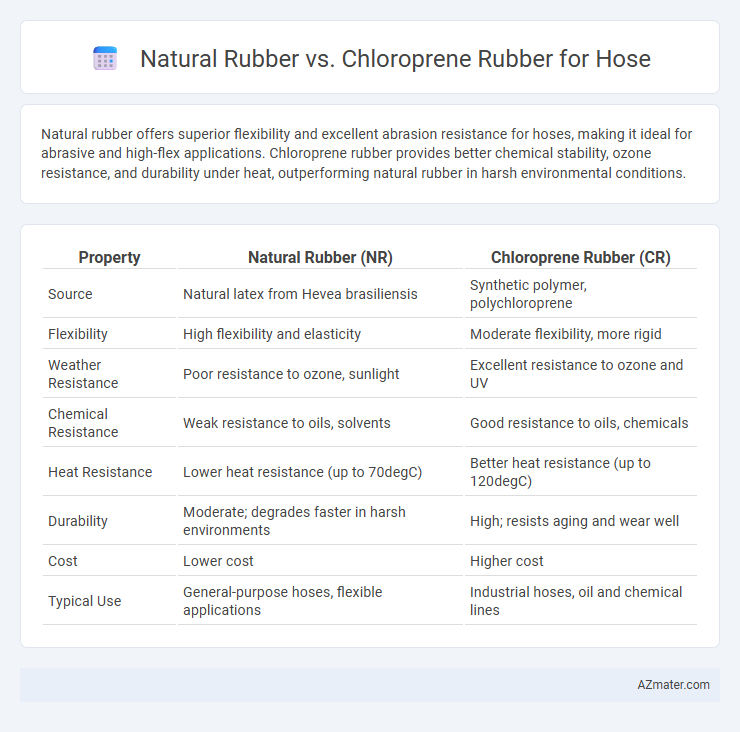Natural rubber offers superior flexibility and excellent abrasion resistance for hoses, making it ideal for abrasive and high-flex applications. Chloroprene rubber provides better chemical stability, ozone resistance, and durability under heat, outperforming natural rubber in harsh environmental conditions.
Table of Comparison
| Property | Natural Rubber (NR) | Chloroprene Rubber (CR) |
|---|---|---|
| Source | Natural latex from Hevea brasiliensis | Synthetic polymer, polychloroprene |
| Flexibility | High flexibility and elasticity | Moderate flexibility, more rigid |
| Weather Resistance | Poor resistance to ozone, sunlight | Excellent resistance to ozone and UV |
| Chemical Resistance | Weak resistance to oils, solvents | Good resistance to oils, chemicals |
| Heat Resistance | Lower heat resistance (up to 70degC) | Better heat resistance (up to 120degC) |
| Durability | Moderate; degrades faster in harsh environments | High; resists aging and wear well |
| Cost | Lower cost | Higher cost |
| Typical Use | General-purpose hoses, flexible applications | Industrial hoses, oil and chemical lines |
Introduction to Natural Rubber and Chloroprene Rubber
Natural rubber, derived from the latex of Hevea brasiliensis trees, offers excellent elasticity, tensile strength, and resistance to abrasion, making it ideal for flexible hose applications. Chloroprene rubber, a synthetic elastomer also known as neoprene, provides superior resistance to oils, chemicals, and weathering, enhancing hose durability in harsh environments. Both materials serve critical roles in hose manufacturing, with natural rubber preferred for general flexibility and chloroprene used for chemical and environmental resilience.
Key Properties of Natural Rubber for Hose Applications
Natural rubber offers excellent elasticity, high tensile strength, and superior abrasion resistance, making it ideal for hose applications requiring flexibility and durability. Its outstanding resilience ensures efficient performance under dynamic pressure and repeated bending, while its excellent sealing capability prevents leaks and fluid loss. Natural rubber's good resistance to water, mild chemicals, and weathering enhances hose longevity in various environmental conditions.
Key Properties of Chloroprene Rubber for Hose Applications
Chloroprene rubber (CR) exhibits excellent resistance to oils, chemicals, and weathering, making it highly suitable for hose applications exposed to harsh environments. Its superior flexibility and abrasion resistance ensure durability and longevity in dynamic and abrasive conditions. The material also offers good tensile strength and compression set resistance, maintaining hose integrity under pressure and repeated use.
Comparative Chemical Resistance: Natural vs Chloroprene Rubber
Natural rubber exhibits strong resistance to abrasion and tearing but is vulnerable to oils, fuels, and many chemicals, limiting its chemical resistance in hose applications. Chloroprene rubber offers superior chemical resistance, particularly against oils, ozone, weathering, and many chemicals, making it more suitable for hoses exposed to harsh environments. The enhanced molecular stability of chloroprene rubber provides better longevity and performance in chemically aggressive conditions compared to natural rubber.
Mechanical Strength and Flexibility Analysis
Natural rubber offers superior flexibility and elasticity, making it ideal for applications requiring dynamic movement and bending in hoses. Chloroprene rubber, however, exhibits enhanced mechanical strength with higher tensile and tear resistance, providing improved durability under pressure and abrasion. When selecting hose materials, natural rubber excels in flexibility-related performance, while chloroprene rubber ensures long-term mechanical robustness.
Temperature Performance: Which Rubber Performs Better?
Natural rubber exhibits excellent resilience and flexibility at moderate temperatures, typically performing optimally between -50degC to 70degC, but it degrades rapidly when exposed to temperatures above 80degC. Chloroprene rubber, also known as neoprene, offers superior temperature resistance, maintaining flexibility and structural integrity in a wider range from -40degC to 120degC, making it more suitable for hose applications exposed to elevated heat. The enhanced thermal stability and weather resistance of chloroprene rubber ensure longer service life and performance reliability in demanding temperature environments.
Durability and Aging: Longevity of Hose Materials
Natural rubber offers excellent flexibility and abrasion resistance but shows limited durability against ozone, UV exposure, and aging, leading to potential cracking and reduced lifespan in harsh environments. Chloroprene rubber (neoprene) exhibits superior resistance to ozone, chemical degradation, and weathering, significantly enhancing hose longevity under prolonged exposure to environmental stressors. For applications requiring extended service life and exposure to oils or chemicals, chloroprene rubber outperforms natural rubber in maintaining hose durability and aging resistance.
Cost Comparison: Natural Rubber vs Chloroprene Rubber
Natural rubber hoses generally offer a lower initial cost compared to chloroprene rubber hoses, making them a budget-friendly option for many industrial applications. Chloroprene rubber, also known as neoprene, tends to be more expensive due to its superior chemical resistance, weather durability, and longer lifespan. When evaluating total cost of ownership, chloroprene hoses can provide better value through reduced maintenance and replacement frequency in harsh environments.
Typical Applications and Industry Preferences
Natural rubber excels in applications requiring high elasticity, tensile strength, and resistance to wear and tear, making it ideal for automotive hoses, industrial air and water hoses, and agricultural equipment. Chloroprene rubber (Neoprene) is preferred in environments demanding superior chemical, ozone, and weather resistance, such as in oil and gas industries, refrigerant hoses, and chemical processing plants. Industry preferences favor natural rubber for cost-effective general-purpose hoses, while chloroprene rubber is chosen for specialized uses requiring enhanced durability and environmental resistance.
Conclusion: Choosing the Right Rubber for Hose Manufacturing
Natural rubber offers excellent elasticity, abrasion resistance, and resilience, making it ideal for hoses used in flexible, high-stress applications such as air and water hoses. Chloroprene rubber, known for its superior chemical resistance, ozone resistance, and weatherability, is preferred in hoses exposed to oils, fuels, and harsh environmental conditions. Selecting the right rubber depends on balancing factors like application environment, chemical exposure, and mechanical demands to ensure hose durability and performance.

Infographic: Natural rubber vs Chloroprene rubber for Hose
 azmater.com
azmater.com